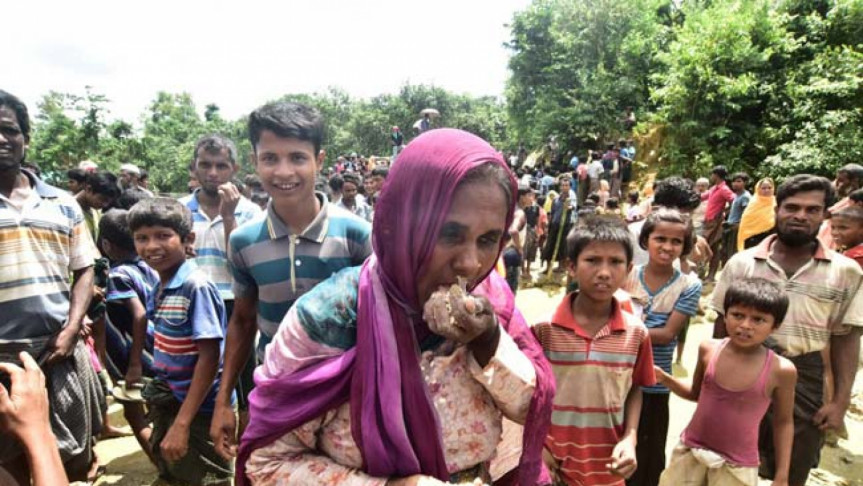Homeless people fight to survive hunger in Rohingya camps

Hundreds of more traumatized and exhausted Rohingyas fled violence in Myanmar and took shelter on the two sides of Ukhiya and Teknaf roads in Cox’s Bazar, near the Bangladeshi border.
As the two other Rohingya shelter camps—Kutupalang and Balukhali— have already exceeded its capacities, new arrivals are crowding in the roadside area, which causes huge traffic congestions on the main road. The movement of vehicles increased; as many of those are carrying relief materials from different parts of the country with regular aid vehicles. Rohingyas are seen running behind relief-laden vehicles, mainly organised by individuals.
Rohingya refugees packed into camps and makeshift settlements in the two upazilas of Cox’s Bazar are becoming desperate and frantic for inadequate basic resources and declining supplies.
Fights are erupting over food and water. Women and children are rubbing their bellies and begging for food.

Stocks are running out with the refugees’ needs far greater than what we had imagined.
Like any other Bangladesh-Myanmar border points, Rohingya families are fleeing violence in their own country Myanmar and entering neibouring Bangladesh through the Anjuman Para, a hamlet of Palongkhali in Ukhia.
Green paddy fields are on one side of the village and the River Naf on another side. And after the Naf, the hill is in sight. Local residents and Rohingya people have named the hill as ‘Kalapahar’. The hill is now another name of horror among the Rohingya people. During the Eid-ul-Azha and after the Eid, local people of the village witnessed the smoke rising behind the hill. That identified the doubt that the village was burning.
The journalist talked to at least nine newly arrived Rohingya families who entered small Anjuman Para border village of Palongkhali on Monday, they testified that the Burma military responded with indiscriminate killings, burning entire villages and forcing tens of thousands to flee.
The influx of Rohingya people was expected to bulge further, with thousands crossing the border each day, and fights have erupted over food and water.
Women and children were tapping on car windows or tugging at the clothes of passing reporters while rubbing their bellies and begging for food.
There is a warning of the potential for outbreaks of disease. Many of the newly-arrived were initially stunned and traumatised after fleeing the violence. They are now mounting desperate in searching for food distribution points that appeared only in recent days.
At one food distribution point, women were volunteering to help keep order by tapping people with bamboo sticks to gently urge them back in line.
Weary women carried infants in their arms while clutching other children to their sides, frightened they might be separated in the crowds.

Mentioning that Bangladesh has given shelter to the Rohingyas on humanitarian grounds, Bangladesh Prime Minister Sheikh Hasina on Monday categorically said Myanmar has to take back its citizens. Taking part in the general discussion in the parliament on a resolution urging the United Nations and the world community to exert strong pressure on Myanmar to take Rohingyas back from Bangladesh, she also said the Myanmar government has to create a safe zone, if necessary, to give them a secure atmosphere.
Offering any sort of assistance to the neighbor, the premier said Myanmar have to resolve their created Rohingya crisis. ‘We haven’t done this considering them as Muslims or Hindus. We just consider them as human beings,’ Sheikh Hasina added.
Relocation
This is creating a huge challenge for Bangladesh in terms of providing shelter as well as other humanitarian assistance to them. Bangladesh government is seeking international support for its plan to relocate Rohingya Muslims fleeing violence in Myanmar to a remote Bay of Bengal island that critics say is flood-prone and unlivable. Bangladesh urged the international community to push Myanmar to find a permanent solution to this crisis and sought support for transportation of the Rohingya to Bhashan Char, also known as Thengar Char. Bangladesh, one of the world’s poorest and most crowded nations, plans to develop Thengar Char, which only emerged from the silt off Bangladesh’s delta coast 11 years ago and is two hours by boat from the nearest settlement.
Rohingya Influx
More than 300,000 Rohingya have fled to Bangladesh from Buddhist-majority Myanmar since the latest violence began on August 25, joining more than 400,000 others already living there in cramped makeshift camps. The United Nations’ top human rights official on Monday slammed Myanmar for conducting a ‘cruel military operation’ against the Rohingya, branding it ‘a textbook example of ethnic cleansing’.
More than 1,000 people have been killed in Myanmar, most minority Rohingya Muslims, more than twice the government’s total. In the last two weeks alone more than 300,000 mostly Rohingya civilians have fled to Bangladesh, overwhelming refugee camps at Ukhia and Teknaf in Cox’s Bazar that were already bursting at the seams. The Rohingya have long been subjected to discrimination in mostly Buddhist Myanmar, which denies them citizenship. The Rohingyas are a stateless Muslim minority who has faced extreme poverty for decades.
The Burmese military entered northern Rakhine state—and over the next four months detained and killed men, women and children. The army men burned down houses and raped women and young girls. The UN report says these actions amount to possible crimes against humanity and ethnic cleansing.










